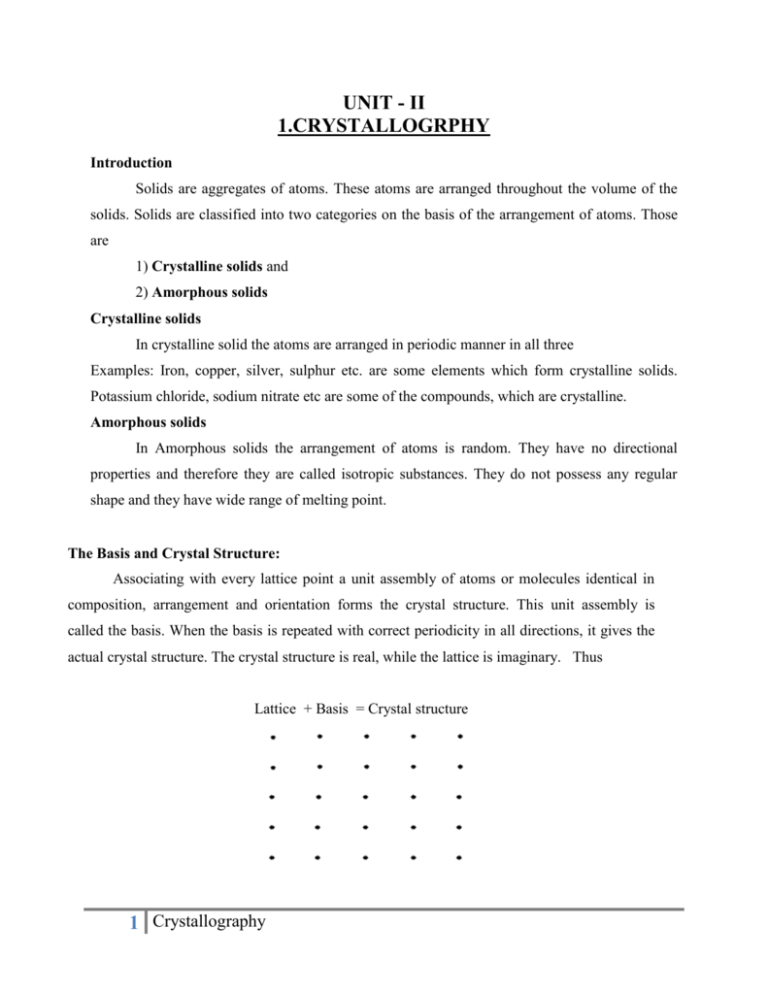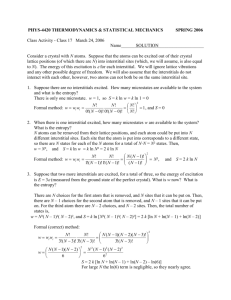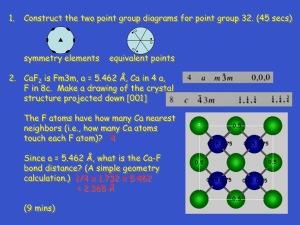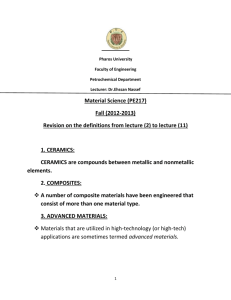Lattice + Basis = Crystal structure
advertisement

UNIT - II 1.CRYSTALLOGRPHY Introduction Solids are aggregates of atoms. These atoms are arranged throughout the volume of the solids. Solids are classified into two categories on the basis of the arrangement of atoms. Those are 1) Crystalline solids and 2) Amorphous solids Crystalline solids In crystalline solid the atoms are arranged in periodic manner in all three Examples: Iron, copper, silver, sulphur etc. are some elements which form crystalline solids. Potassium chloride, sodium nitrate etc are some of the compounds, which are crystalline. Amorphous solids In Amorphous solids the arrangement of atoms is random. They have no directional properties and therefore they are called isotropic substances. They do not possess any regular shape and they have wide range of melting point. The Basis and Crystal Structure: Associating with every lattice point a unit assembly of atoms or molecules identical in composition, arrangement and orientation forms the crystal structure. This unit assembly is called the basis. When the basis is repeated with correct periodicity in all directions, it gives the actual crystal structure. The crystal structure is real, while the lattice is imaginary. Thus Lattice + Basis = Crystal structure 1 Crystallography Lattice Basis Crystal Structure Above figures show crystal structure from Space lattice and Basis. It is observed from the figure that the basis consists of two atoms. The number of atoms in the basis may vary from a single atom to many atoms. For example in sodium and copper, the basis is single atom and in NaCl and CsCl, the basis is diatomic. Unit Cell: The atomic order in crystalline solids indicates that the small groups of atoms form a repetitive pattern. Thus in describing crystal structures, it is often convenient to subdivide the 2 Crystallography structure into small repeat entities called unit cells. A unit cell is chosen to represent the symmetry of the crystal structure, where in all the atomic positions in the crystal may be generated by translation of the unit cell integral distances along each of its edges. Thus the unit cell is the basic building block of the crystal structure. Unit cell for most crystals are parallelepiped or cubes having three sets of parallel faces. The choice of a unit cell is not unique but can be constructed in a number of ways as shown in the figure. The unit cell should be chosen in such a way that it gives the symmetry of crystal lattice. The figure above shows a unit cell of a three-dimensional crystal lattice. Lattice Parameters of a unit cell: In order to define lattice parameters, we should first define axes. The crystallographic axes are those lines drawn parallel to the lines of intersection of any three faces of the unit cell which do not lie in the same plane. The angles between the three crystallographic axes are known as interfacial angles and are denoted by , and . The intercepts a, b and c on crystallographic axes (x, y and z ) define the dimensions of unit cell and are known as primitives or characteristic intercepts on the axes. These primitives and interfacial angles constitute the lattice parameters of the unit cell. It is thus obvious that if the values of these intercepts and interfacial angles are known, we can easily determine the form and actual size of the unit cell. 3 Crystallography Primitive Cell: Primitive cell is defined as the unit cell that contains one lattice point at corners. Thus the number of lattice points per unit cell is one. The unit cell differs from the primitive cell in that it is not restricted to begin the equivalent of one lattice point. Carbon crystallized polymers and plastics are examples of nonmetallic crystals or amorphous solids. Difference between amorphous and crystalline solids Crystalline Solids 1.They have long range order of atoms 2.Crystals have sharp melting points 3.Because they have regular arrangement, their properties vary with direction, hence they are anisotropic 4. Cleavage of crystal occurs along certain planes. Amorphous Solids: 1. The arrangement of atoms is random. 2. The don’t have sharp melting point i.e. wide range of melting point. 3. They have no directional property and therefore they are isotropic 4. They give a rough surface on cutting along any direction. Lattice Points: The atomic arrangement in a crystal is called crystal structure. In a perfect crystal there is a regular arrangement of atoms. It is very convenient to imagine points in space about which these atoms are located. Such points in space are called “Lattice Points” and totality of such points forms a crystal lattice or space lattice. If the arrangement is in three dimensions, that arrangement is called 3-D space lattice. Bravais Lattices: A Three dimensional space lattice is generated by repeated translation of three non coplanar vectors a,b and c. There are only fourteen distinguishable ways of arranging of points in three dimensional space. These 14 space lattices are known as Bravais Lattices. These lattices are classified into seven crystal systems. Each system is characterized by the values of lattice 4 Crystallography parameters a,b ,c and α,β,γ. The classification of these systems is shown in the below table. S.No. Crystal System Number of Bravais lattice lattices in the system Unit cell characteristics 1 Cubic 3 a=b=c = == 90o 2 Tetragonal 2 a=bc 3 Orthorhombic 4 1. Simple 2. Body centered 3. Face centered 1. Simple 2. Body centered 1. Simple 2. Base centered 3. Body centered 4. Face centered 1. Simple = == 90o = == 90o 1. Simple a=bc 1. Simple 2. Base centered 1. Simple abc 4 5 Rhombohedral 1 (Trigonal) Hexagonal 1 6 Monoclinic 2 7 Triclinic 1 abc a=b=c abc = = 90o = = 90o = 120o = = 90o 90o 90o Crystal Systems: The lattice is made-up of a repetition of unit cells and a unit cell can be completely described by the three vectors a , b and c where the length of vectors and the angles between them (,, ) are completely specified. The vectors a , bc may or may not be equal. Also, the angles , , and may or may not be right angles. Based on these conditions, there are seven different crystal systems. If atoms exist only at the corners of the unit cells, the seven crystal systems will yield seven types of lattices. These seven basic crystal systems are distinguished from one another by the angles between the three axes and the intercepts of the faces along them. The basic crystal structures are: 5 Crystallography (1) Cubic system: In this system all the three vectors are equal in magnitude and are perpendicular to each other i.e. a= b = c and = = = 90o. These crystals have three types of lattices depending upon arrangement of atoms. They are simple cubic, body centered and face centered cubic. Examples: Au, Cu and NaCl (2) Tetragonal system: In this system all the two vectors are equal in magnitude and are perpendicular to each other i.e. a = b c and = = = 90o. There are two lattices in this system, simple and body centered. Examples: TiO2, SnO2 and NiSO4 (3) Orthorhombic system: In This system, the crystal axes are perpendicular to one another, but the repetitive interval are different along the three axes i.e. a b c and = = = 90o. Orthorhombic may be simple, body centered, base centered and face centered. Examples: KNO3, BaSO4 and PbCO3 6 Crystallography (4) Monoclinic system: In this system three vectors are unequal in magnitude and two of the crystal axes are perpendicular to each other but the third is obliquely inclined i.e.a b c and = =90o These crystals have two types of lattices depending upon the arrangement of atoms. Simple and base centered systems. Examples: CaSO4.2H2O, FeSO4 and Na2SO4 (5) Triclinic system In this system all the three vectors are unequal in magnitude and no crystal axis is perpendicular to each other i.e. a b c and 90o . The try clinic lattice is only one lattice. Examples: K2Cr2O7 and CuSO4.5H2O 7 Crystallography (6) Trigonal (or Rhombohedral) system: In this system the The three axes are equal in length and are equally inclined to each other at an angle other than 90o. i.e.a = b = c and = = 90o Examples: As, Sb, Bi and Calcite (7) Hexagonal system: In this system a = b c and = = 90o = 120o.Two axes of the unit cell are equal in length in one plane at 120o with each other and third axes is perpendicular to this plane. Examples: SiO2, Zn, Mg and Cd 8 Crystallography Properties of Unit Cell: Coordination number: Coordination number is defined as the number of equi-distant nearest neighbors that an atom has in the given structure. Nearest neighbor distance: The distance between the centers of two nearest neighboring atoms is called nearest neighbor distance. It will be ‘2r’ if ‘r’ is the radius of the atom Atomic Packing Factors: The fraction of the space occupied by atoms in a unit cell is known as atomic packing factor. It is the ratio of the volume of the atoms occupying the unit cell to the volume of the unit cell relating to that structure. Atomic packing factor = PACKING FRACTIONS: Simple Cubic Structure (SC): Simple cubic structure is shown in the figure. In a simple cubic lattice there is one lattice point at each of the eight corners of the unit cell. Each atom in this lattice is surrounded by six equidistant nearest neighbors hence the coordination number is six. In this structure, eight unit cells share each corner atom. Hence share of each corner atom to a unit cell is 1/8 of an atom. Therefore the total number of atoms (or effective number of atoms) in one unit cell will be 1 x 8 = 1. Atom 8 9 Crystallography Thus SC is a primitive cell. The atoms in this structure touch each other along the cube edge. Hence nearest neighbor distance (2r) = a , where ‘a’ is the side of the cube and ‘r’ is radius of atoms. Volume of the atoms in unit cell v = 4 3 r 3 Volume of unit cell V = a 3 = (2r)3 4 3 r v 3 Atomic packing factor for simple cubic (SC) structure is = = 0.52 or 52% 3 V (2r ) 6 Hence SC is a loosely packed structure. The element polonium at a certain temperature region exhibits this structure. Body centered Cubic Structure (BCC): 10 Crystallography In this structure, a unit cell contains 8 atoms at the eight corners and another atom at the body center. Eight unit cells share each corner atom. Therefore the number of atoms per unit cell in a BCC structure is ( 1 x 8) + 1 = 2 atoms 8 The corner atoms don’t touch each other, but each corner atom touches the body center atom along body diagonal. Hence coordination number = 8. The side of the cube is ‘ a ’ and radius of atom is ‘r’. From the figure,the nearest neighbor distance 2r = 3 a 2 Volume of all the atoms in a unit cell v = 2 x Volume of unit cell = a 3 = ( 4r 3 4 3 r 3 )3 4 2 r3 v 3 Atomic packing factor = = 0.68 or 68% 3 V 4r 3 Packing factor is 68%. Li, Na, K and Cr exhibit this structure. 11 Crystallography Face centered Cubic Structure (FCC): In the case of FCC lattice, there are eight atoms at the eight corners of the unit cell and six atoms at the centers of six faces shown in figure. The unit cell face is common to two unit cells and there are twelve points surrounding it situated at a distance equal to half the face diagonal of the unit cell. Thus coordination number of FCC is 12. Each of the six face centered atoms is shared by two adjoining cubes. 8 surrounding unit cells share each of the corner atoms. 1 1 Total number of atoms per unit cell = ( 8 ) + ( 6 ) = 4 atoms 8 2 From the figure (4r) = 2a Nearest neighbor distance 2r = 2 a 2 where ‘r’ is radius of atom and ‘ a ’ is side of the cube. Volume of all the atoms in unit cell (v) = 4 x 4 3 r 3 Volume of unit cell (V) = a 3 4 4 r3 v 3 Atomic packing factor = = = 0.74 or 74% 3 V 4r 2 Therefore FCC is a close packed Structure. Copper, aluminum, lead and silver have this structure. 12 Crystallography Relationship between lattice constant and density of a crystal: (cubic only) Let ‘’ be the density of the material. The volume of a unit cell for a cubic lattice is ‘a3’.Hence mass of the unit cell = a3. Let ‘n’ be the number of atoms or molecules in a unit cell. Mass of an atom or molecule = M ; where M is the atomic or molecular weight and NA is NA the Avogadro number. a 3 13 Crystallography nM NA or a3 nM N A





